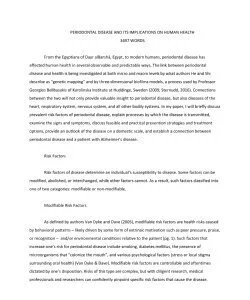PERIODONTAL DISEASE AND ITS IMPLICATIONS ON HUMAN HEALTH 3497 WORDS
PERIODONTAL DISEASE AND ITS IMPLICATIONS ON HUMAN HEALTH 3497 WORDS
PERIODONTAL DISEASE AND ITS IMPLICATIONS ON HUMAN HEALTH
3497 WORDS
From the Egyptians of Dayr alBarshā, Egypt, to modern humans, periodontal disease has affected human health in several observable and predictable ways. The link between periodontal disease and health is being investigated at both micro and macro levels by what authors He and Shi describe as “genetic mapping” and by three-dimensional biofilms models, a process used by Professor Georgios Belibasakis of Karolinska Institute at Huddinge, Sweden (2009; Sternudd, 2016). Connections between the two will not only provide valuable insight to periodontal disease, but also diseases of the heart, respiratory system, nervous system, and all other bodily systems. In my paper, I will briefly discuss prevalent risk factors of periodontal disease, explain processes by which the disease is transmitted, examine the signs and symptoms, discuss feasible and practical prevention strategies and treatment options, provide an outlook of the disease on a domestic scale, and establish a connection between periodontal disease and a patient with Alzheimer’s disease.
Risk Factors
Risk factors of disease determine an individual’s susceptibility to disease. Some factors can be modified, abolished, or interchanged, while other factors cannot. As a result, such factors classified into one of two categories: modifiable or non-modifiable.
Modifiable Risk Factors
As defined by authors Van Dyke and Dave (2005), modifiable risk factors are health risks caused by behavioral patterns – likely driven by some form of extrinsic motivation such
